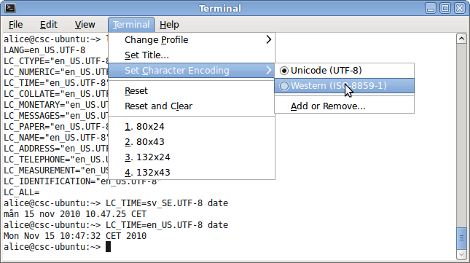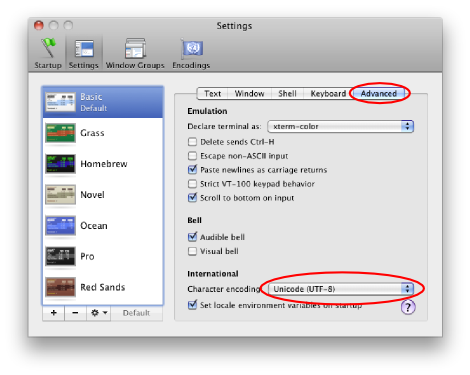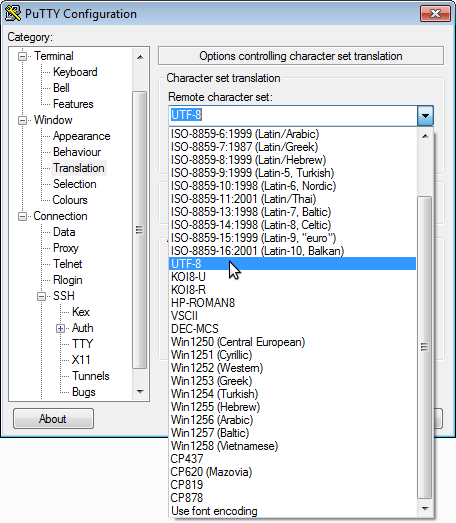E Type Here I Go Again Ñâãâºãâ°ã‘‡ãâ°ã‘‚ã‘å’
When files are moved between different operating systems, or stored in a common file organisation such as AFS, you may sometimes find that characters such equally ÅÄÖ are shown incorrectly.
A graphic symbol encoding determines which binary sequence is used to stand for each letter, or other character. Many different ways to encode text take been used throughout the years. CSC'due south Unix systems accept traditionally used "Latin-ane" (ISO-8859-one), which contains the letters used in western European languages. Other operating systems have used other encodings, e.g. "Mac Roman" on Mac OS, "CP-1252" on MS Windows, or "CP-437" on MS DOS. All of these are extensions of ASCII (basically, American letters, digits and punctuation), which means that such characters are displayed correctly. Merely accented letters differ. In detail, the Swedish letters ÅÄÖ are not displayed correctly
These days, most OSs tin can use some form of UTF-eight, but you may need to configure the applications to employ it. To do so yous cull a locale, which defines formatting many settings specific to a linguistic communication and region, for example:
- Number formatting (e.g. using "1 234,5" or "ane,234.v")
- Date and fourth dimension formatting
- String collation (i.east. sort gild, and then that "ångström" is sorted nether A in English language but Å in Swedish)
The locale is written as «language»_«variant».«encoding», e.1000. "en_US.UTF-eight" (American English, UTF-8) or "en_GB.ISO8859-1" (British English, latin-one).
Wikipedia's explanation of latin1 (external link)
Wikipedia's explanation of locales (external link)
Converting a file
To convert the contents of a file, you can open up it in a locale-aware editor, and "salve as..."
a unlike encoding, or utilise the iconv control-line tool:
iconv -f iso8859-1 -t utf-8 < original.txt > new.txt
When logging in remotely (with SSH), you can ordinarily configure your local settings to exist forwarded. Unfortunately, not all SSH servers back up this. Currently (as of November 2010), CSC's Solaris SSH server does not permit forwarding of environment variables, which is needed for this to piece of work. The relevant locales (en_US.UTF-8, sv_SE.UTF-8) are available on Solaris, and y'all can set them manually, but they won't be used past default.
Problem: ÅÄÖ shown as ���
Your application uses latin1 characters, but your concluding (or editor) tries to display them as UTF-8. Configure your application to apply UTF-viii (come across beneath), or alter your concluding settings to apply ISO-8859-1.
Trouble: ÅÄÖ shown as åäö
Your awarding uses UTF-8, but they are displayed as latin1. Configure your application to use ISO-8859-1 (encounter below), or change your last settings to use UTF-viii.
Problem: ÅÄÖ shown as ���
Your awarding is printing U+FFFD, the Unicode replacement character (�, normally displayed every bit a question marking on inverted groundwork). This is then converted as if it were in latin1 to UTF-8 (a U+FFFD graphic symbol in UTF-eight uses three bytes). Check the settings for all applications — including the terminal window — to ensure that they all agree on which encoding to use.
Select locale (application settings)
If your application is locale aware (most are, merely non some legacy CSC applications), then you can select the locale by
export LC_ALL=en_US.UTF-8 ## bash
setenv LC_ALL en_US.UTF-eight ## tcsh
so run your application. To only configure the character encoding, change the LC_CTYPE surround variable instead.
You tin can also select which locale to use when you log in locally, but this may cause trouble when you use a different operating organisation. We recommend that you use the default settings and re-configure the applications instead.
Configuring last encoding
Ubuntu
The encoding used by Gnome's terminal can exist modify under Concluding so Fix Graphic symbol Encoding, but unless you accept previously done so, you need to add together the "Western (ISO-8859-i)" encoding.

Mac OS Ten
The default settings for Terminal.app is to apply UTF-8. This can be changed by going to Terminal then Preferences… then Advanced.

The default for X11.app's xterm is to apply latin1. You can alter this by editing the startup sequence for X11, only information technology'south easier to but use Final.app.


MS Windows
PuTTY's settings can be changed under Window so Translation in the configuration dialog.

CSC's Windows computers currently run SSH Secure Beat from Tectia (formerly SSH Communications Security Corp). It is not UTF-8 aware, and will default to using latin1 encoding.
Source: https://intra.kth.se/en/it/arbeta-pa-distans/unix/encoding-1.71788
Post a Comment for "E Type Here I Go Again Ñâãâºãâ°ã‘‡ãâ°ã‘‚ã‘å’"